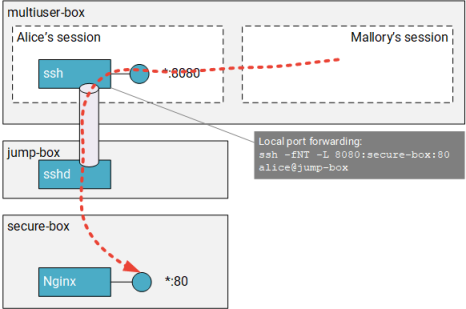


Pin A visual example of an SSH tunnel and the associated command You want to access this service from your local computer, but a firewall is in the way. Let’s say there is a service on a remote server that is running on port 80.
#Ssh tunnel 80 how to
In our next article, we will show how to disable SSH local port forwarding.Learn how to setup a basic SSH tunnel to access remote server resources that may be blocked by a firewall or simply inaccessible over the internet. Attackers can use it for malicious activities. You can add your voice to this guide via the feedback form below.Īttention: SSH port forwarding has some considerable disadvantages, it can be abused: it can be used to bypass network monitoring and traffic filtering programs (or firewalls). This is one of the very many uses of SSH. In this article, we explained the various types of port forwarding from one machine to another, for tunneling traffic through the secure SSH connection. Read Also: 5 Ways to Keep Remote SSH Sessions Running After Closing SSH Summary Note that the SOCKS proxy will stop working after you close your SSH session. $ ssh -f -N -D 1080 įrom now on, you can make applications on your machine use this SSH proxy server by editing their settings and configuring them to use it, to connect to your remote server. The following command will start a SOCKS proxy on port 1080 allowing you to connect to the remote host. You can enable dynamic port forwarding using the -D option. Dynamic port forwarding sets up your machine as a SOCKS proxy server that listens on port 1080, by default.įor starters, SOCKS is an Internet protocol that defines how a client can connect to a server via a proxy server (SSH in this case).
#Ssh tunnel 80 full
Unlike local and remote port forwarding which allows communication with a single port, it makes possible, a full range of TCP communications across a range of ports. This is the third type of port forwarding. Tunnels such as Ngrok, pagekite, localtunnel, and many others work in a similar way. Once you understand this method of tunneling, you can easily and securely expose a local development server, especially behind NATs and firewalls to the Internet over secure tunnels. Next run the following command to forward port 5000 on the remote machine to port 3000 on the local machine. Next, you need to restart sshd to apply the recent change you made. Look for the required directive, uncomment it, and set its value to yes, as shown in the screenshot. Open the file for editing using your favorite command-line editor. You can enable this using the GatewayPorts directive in your SSHD main configuration file /etc/ssh/sshd_config on the remote host. By default, SSH does not permit remote port forwarding. Remote port forwarding allows you to connect from your remote machine to the local computer.

Access a Remote App via Local SSH Port Forwarding Remote SSH Port Forwarding Now, on your local machine, open a browser, instead of accessing the remote application using the address :3000, you can simply use localhost:8080 or 192.168.43.31:8080, as shown in the screenshot below. The -f switch instructs ssh to run in the background. $ ssh -L 8080::3000Īdding the -N flag means do not execute a remote command, you will not get a shell in this case. The -L flag defines the port forwarded to the remote host and remote port. You can forward a local port (e.g 8080) which you can then use to access the application locally as follows. Assuming you are behind a restrictive firewall or blocked by an outgoing firewall from accessing an application running on port 3000 on your remote server. This type of port forwarding lets you connect from your local computer to a remote server.
#Ssh tunnel 80 password
$ ssh Connect Remote SSH Without Password Local SSH Port Forwarding In this example, I have configured passwordless SSH login between my local and remote hosts, so it has not asked for user admin’s password. Usually, you can securely connect to a remote server using SSH as follows.


 0 kommentar(er)
0 kommentar(er)
